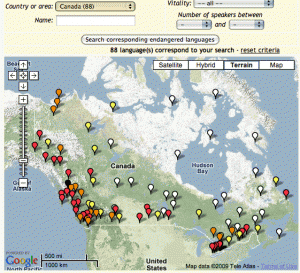http://www.ethnologue.com/web.asp
The Ethnologue is a reference resource that catalogues all of the world’s known living languages—all 6909 of them. The Ethnologue is available to order in print or a version can be found free online. It was created by scholars through SIL International (Summer Institute of Linguistics), an organization dedicated to working with speakers of lesser-known languages (many of which are indigenous languages or variants of indigenous languages) to record, study and assist in revitalizing the language.
Upon arrival at the home page, there are many ways to look up language information. One can look at language families, geographical regions or endangered languages only, for example, in order to find what they are looking for. Maps, diagrams and statistical summaries of language-related information are available throughout the site, and for each entry there is a breakdown of the language’s status: how many speakers of the language, with a distinction between L1 (native) and other speakers; where the language is spoken in the world; how many cultural members of the language group exist; the language family it belongs to; other names for the language; and where to find more information on the language—often links to academic articles.
Of particular interest to the study of indigenous community reality is the Endangered Languages section. Here you will find not only information regarding specific languages, but also a link to SIL’s endangered languages policy, which explains more about why linguists want to work with these languages and stop them from dying out unrecorded. It is also important to keep in mind, however, that much of the research is carried out by non-cultural members, and that despite the well-meaning efforts of SIL International, after centuries of colonization, some communities may not desire to have their language recorded or documented. After all, at its outset, SIL was a Christian organization that began by translating biblical information for indigenous communities–colonization at its best. Although SIL is still guided by Christian principles, the Ethnologue and other SIL publications are now non-denominational, research-based works.

